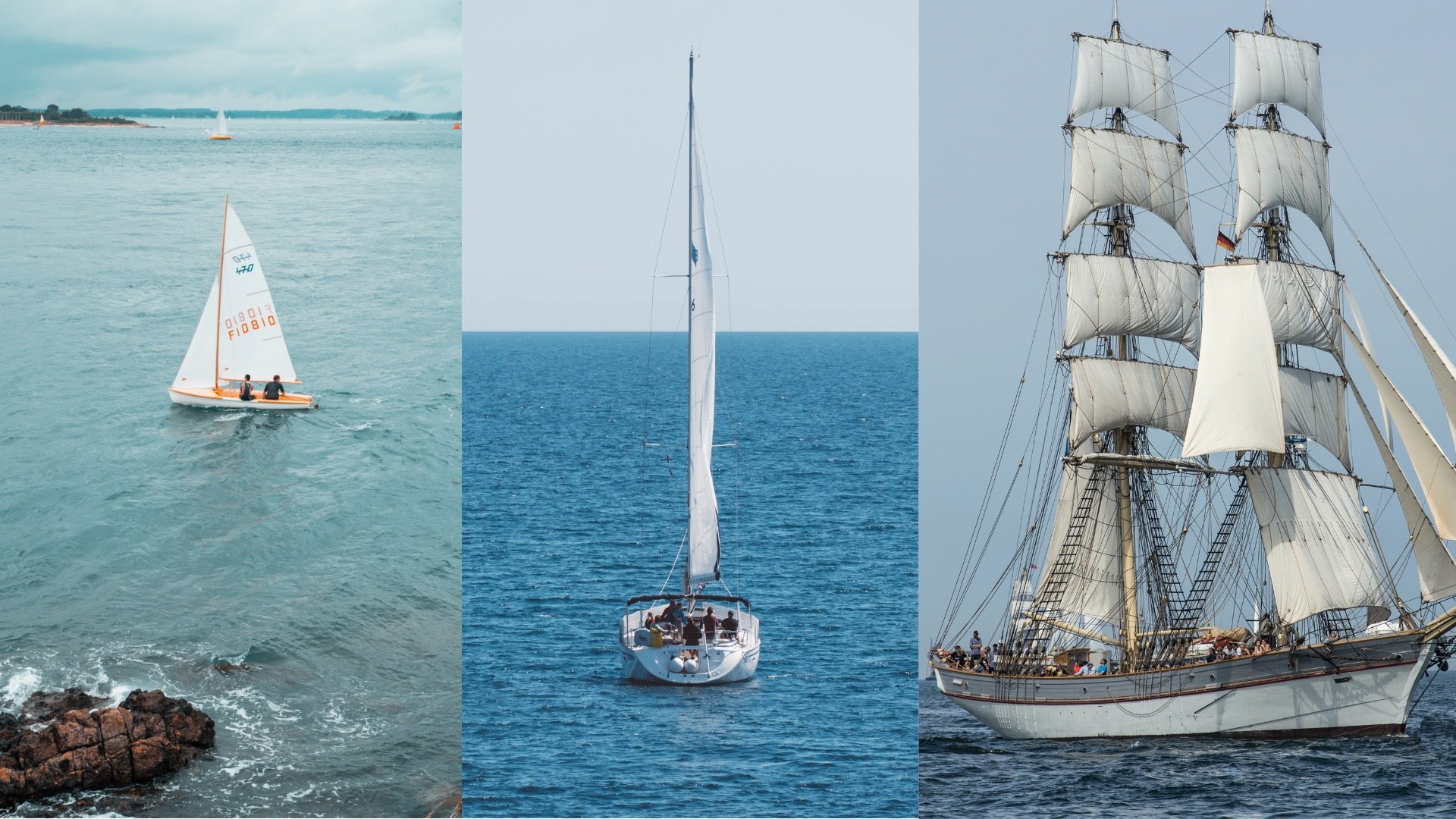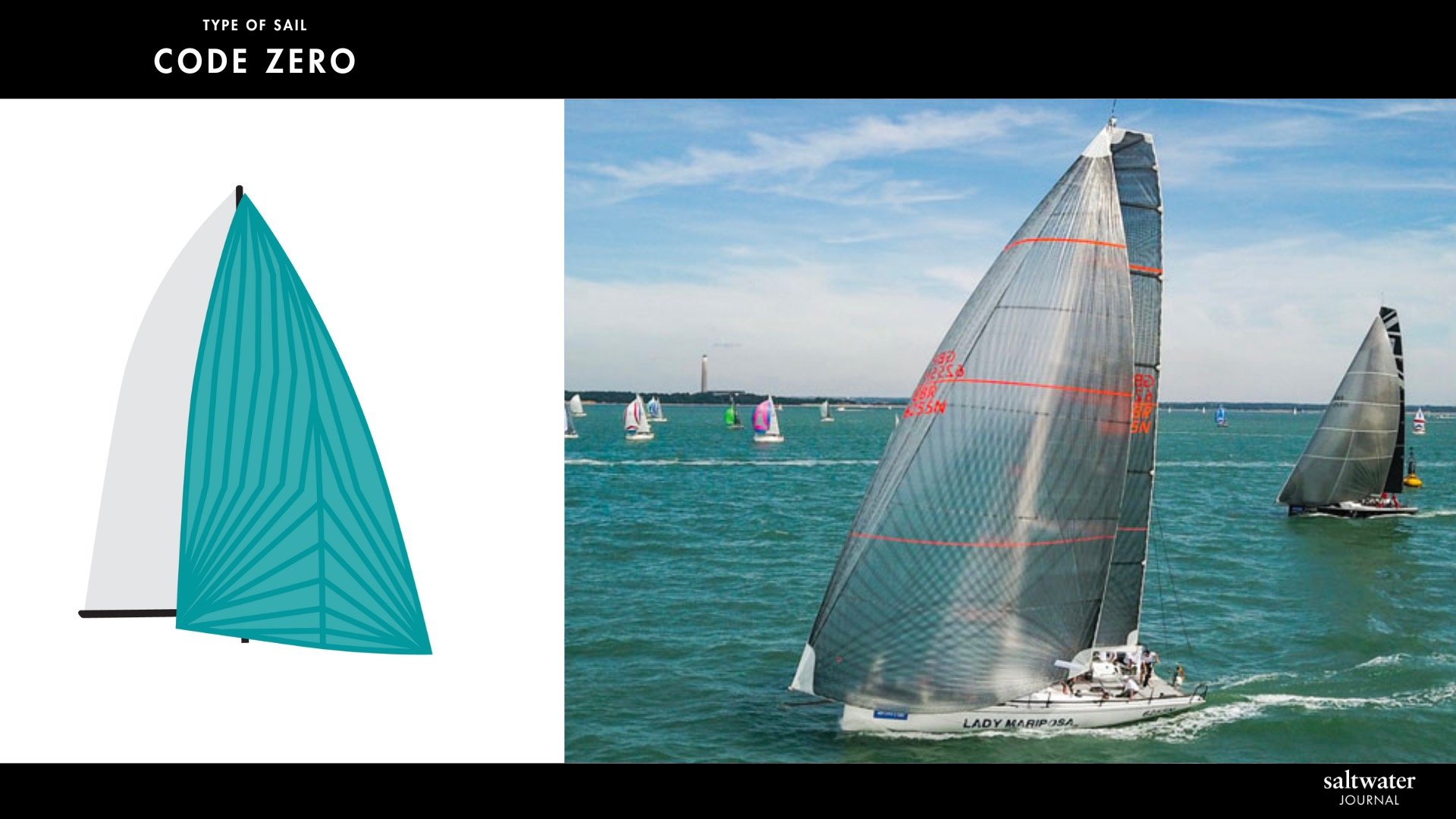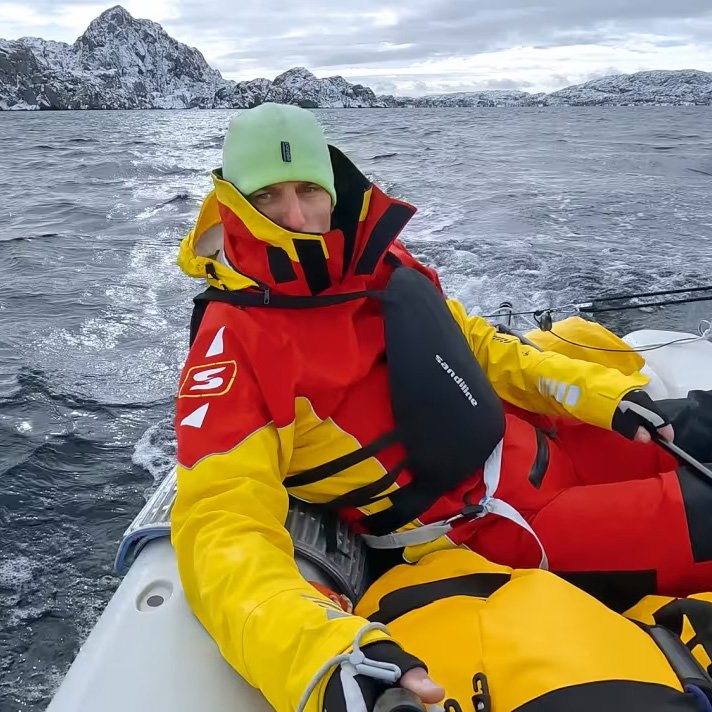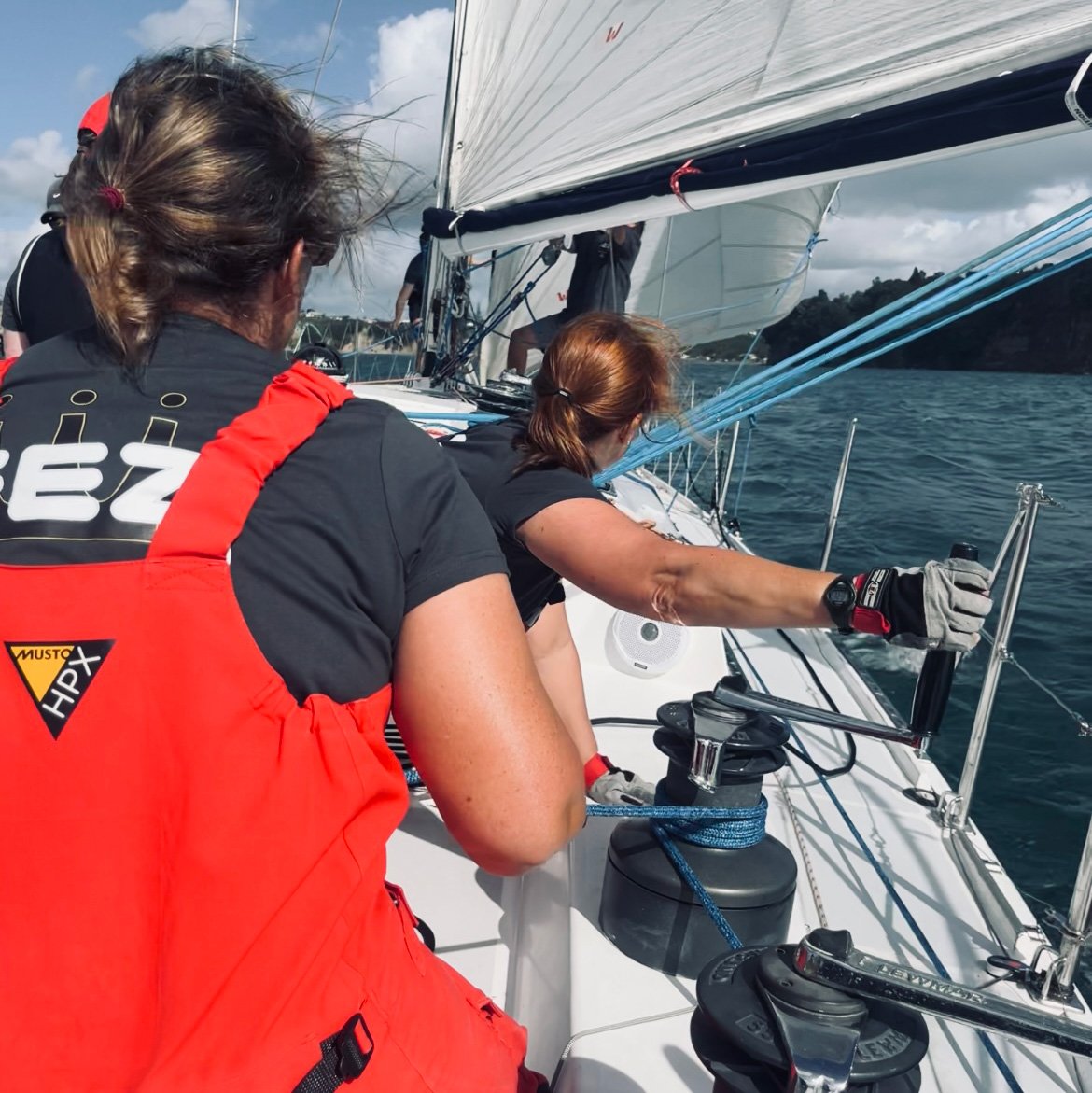Beginner’s Guide to Types of Sails
Saltwater Journal is reader supported.
When you buy through our links we may earn an affiliate commission (at no extra cost to you)
Sailing is exhilarating — there’s nothing quite like feeling the wind powering up the sails as you carve through the ocean. It doesn’t matter how small or big, economical or expensive your yacht is — all types of sails use the same principles of aerodynamics to harness the free energy of the wind. As the sails are hoisted, the design elements of shape, size and angle work together with wind and water pressures to propel the yacht forward.
When you’re new to sailing, it looks like a kind of sorcery — of mysterious forces and weaving of lines, canvas and clutch configurations. You might think “How am I ever going to learn this?”. But even seasoned mariners started out by learning the basics one sail at a time, and then spent time on the water to give it a go, testing how the sails work in action. Feeling the magic of sailing!
In this beginner’s guide, we’ll explore the common types of sails used by sailors around the globe and answer some fundamental questions e.g. What are sails made of?, What are the parts of a sail?, How does a sail actually work? and What are the types of sails?. Whether you're an aspiring sailor, or simply curious, this article will provide you with valuable knowledge to begin your sailing adventures.
What are sails made of?
Commonly used sail materials
Not all types of sails are the same, and the choice of material depends on factors such as the design and size of the boat, the sail use, and personal preference (and budget!). Here’s some commonly used materials:
Dacron: Dacron is a polyester fabric and dacron sails are the most popular among cruisers and recreational sailors. Developed during World War II, it’s durable, relatively affordable, and offers good shape-holding properties.
Nylon: Nylon, or polyamide, is a strong and elastic material. Nylon sails are lightweight and have good stretch characteristics, making them suitable for downwind sailing or applications where flexibility is required. The big beautiful spinnakers you’ve seen up in full flight are usually made from nylon.
Mylar: Mylar is a brand name for a polyester film commonly used in sailmaking. It’s lightweight and has low stretch characteristics. Mylar films are often used in combination with other materials in laminate sails to provide added strength and stability.
Kevlar or Carbon Fibre: These two high-performance materials are exceptionally strong and lightweight. Kevlar or carbon fibre sails are commonly used in racing and high-performance sailing. They offer excellent shape retention and are capable of withstanding higher loads. Kevlar is an aramid fibre made of aromatic polyamides. Carbon Fibre is composed of filaments formed by crystals of carbon atoms. If you’ve seen cool black sails out on the harbour — they’ll be one of these two!
Laminate: Laminate sails are made by bonding multiple layers of materials together, typically polyester films and fibres. This construction method allows for a combination of strength, durability, and reduced weight. Laminate sails are often used in racing or performance-oriented sailing.
It's important to note that there are other specialized materials and fabric combinations available for specific sailing applications. Sailmakers can provide guidance on the most suitable material based on individual yacht requirements and different sailing conditions.
What are the parts of a sail?
Here are the main parts of a sail to learn when you’re starting out:
Luff (Front Edge): The luff is the front or leading edge of the sail (the side that faces into the wind). On a mainsail, the luff is usually attached to the mast and hoisted up. On a headsail, the luff is attached to the forestay.
Leech (Outside Edge): The leech is the back or trailing edge of the sail (opposite the luff).
Head (Top Corner): The head is the top corner of the sail, located at the intersection of the luff and the leech. It is typically attached to the mast or a halyard, which hoists the sail.
Tack (Forward Corner): The tack is the lower corner of the sail, positioned at the intersection of the luff and the foot. It is typically attached to the boom, spar or deck of the boat.
Clew (Aft Corner): The clew is the aft lower corner of the sail, where the leech and the foot meet. It is often attached to the boom or a sheet, which controls the angle of the sail.
Foot (Bottom Edge): The foot is the bottom edge of the sail, stretching horizontally between the tack and the clew. It helps determine the overall shape and profile of the sail.
Roach (Amount of sail curve): The roach refers to the curved or extended area of the leech beyond a straight line drawn between the head and the clew. A larger roach increases the sail's area and potential power.
Battens: Battens are slats or rods inserted into pockets or sleeves along the leech of the sail. They help maintain the shape of the sail and prevent excessive fluttering or collapsing.
Reefing points: Reefing points are sets of lines or ties located along the foot or luff of the sail. These allow the sail to be partially lowered or ‘reefed’ to reduce its area in strong winds. There can also be a series of higher reefing points, which reduce the size of the mainsail even more.
Telltales: Telltales are small strips of yarn or fabric attached to various parts of the sail. They provide visual indicators of airflow and help the sailor adjust the sail's trim for optimal performance.
How does a sail work?
The curve of the sails creates opposite wind pressures. The wind force on the sails balanced by the underwater force on the keel moves the yacht forward.
The shape of the sail plays a crucial role in how it works. Sails are designed to be curved, much like an airplane wing. This curvature creates differences in air pressure: the wind flowing over the curved side of the sail travels faster and creates lower pressure, while the wind on the flat side (facing the wind or windward) remains relatively slower with higher pressure. This pressure difference generates lift, just like an airplane wing lifts an airplane upwards.
By adjusting the angle of the sail in relation to the wind, sailors can control the direction in which the boat moves. When the sail is angled correctly, the lift generated by the wind is directed mostly sideways, propelling the boat forward.
Role of the keel
The keel is a heavy, fin-like structure located underneath the boat (see different types of keels here). It helps provide stability and prevents the boat from being pushed sideways by the force of the wind on the sails. The keel is designed to create lift in the water similar to how a sail creates lift in the air.
We’ll start by learning the simple rig and sail set ups shown on the first two sailboats!
Common yacht rigs
Four of the common types of yacht rigs
Before we look at types of sails, it’s important to know the basic types of rig too. A yacht’s rigging refers to the lines (ropes), cables, chains and other systems used to control and support a mast(s) and sails. Common sailboat rigs you’ll see around a marina are Sloop, Cutter and Ketch. We’ll take a look below at the most important and everyday sails for these particular rigs.
What are the common types of sails?
There are many different types of sails — each with variations of size and sub-categories of name. To keep things simple, here’s the most common types of sails you’ll see on cruising and racing boats (Note: Racing boats offshore would use the trysail and storm jib but harbour racing boats wouldn’t likely).
The Mainsail
The mainsail is the primary sail on a boat and is typically the largest. It is positioned on the mast and attached to a boom, which can be swung out to either side of the yacht to get the right wind angle. The mainsail is responsible for generating the majority of the driving force. It can be equipped with battens, which are stiffening elements that help maintain the shape of the sail, improving its performance. Mainsails are available in various designs, including full-batten, partial-batten, and no-batten sails. Each design offers different trade-offs in terms of performance, ease of use, and cost.
Headsails
Headsails, also known as jibs or foresails, are located forward of the mast. They work in conjunction with the mainsail to optimize the boat's performance. There are different types of headsails, each designed for specific wind conditions and points of sail.
The most common headsail types include:
Genoa
Jib
Smaller than a genoa, the jib is ideal for higher wind speeds and closer angles to the wind. Jibs are often used for upwind sailing, where they provide better maneuverability and control.
Storm Jib
A heavy-duty headsail designed for extreme weather conditions. Storm jibs are smaller (usually brightly coloured orange or red) and made from robust materials to withstand high winds.
Spinnaker Sails
Spinnakers are specialized downwind sails that excel in light to moderate breezes. They’re often used for racing or cruising in favorable wind conditions. Spinnakers come in various shapes, including symmetric and asymmetric designs.
Symmetrical Spinnaker
This classic design has equal dimensions on both sides of its vertical axis. It requires a spinnaker pole to hold it out from the boat's bow, allowing it to capture more wind and increase speed.
Asymmetrical Spinnaker
This newer design features an off-center clew, making it easier to handle without a spinnaker pole. Asymmetrical spinnakers are versatile and can be used on different points of sail.
Specialty Sails
In addition to the main categories mentioned above, there are several specialty sails designed for specific purposes:
Gennaker
A hybrid sail combining the characteristics of a genoa and a spinnaker. Gennakers are versatile sails used for sailing both upwind and downwind in light to moderate winds.
Code Zero
A powerful headsail that bridges the gap between a genoa and a spinnaker. It is designed for sailing close to the wind with light to moderate breezes.
Storm Trysail
A small, heavy-duty sail used in extremely stormy conditions. Storm trysails provide an alternative to reefing the mainsail, allowing sailors to maintain control in high winds.
In Summary
Understanding the different types of sails to use for different weather conditions and wind directions is crucial for sailors of all levels. Whether you're looking for enhanced performance, increased speed, or better control in varying wind conditions, choosing the right sail is key. From mainsails to headsails, spinnakers to specialty sails, each type has its unique characteristics and advantages. By familiarizing yourself with these sail types, you'll be better equipped to make informed decisions when it comes to sailing adventures. So, hoist the sails and enjoy learning more out on the water!























